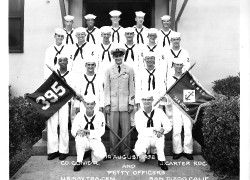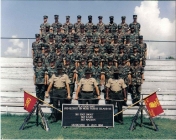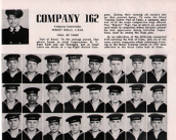The public affairs chief supervises radio and television broadcasting, Army command information and public affairs programs. MOS 46Z50 personnel must be able to supervise personnel performing the duties of MOS 46Q and 46R at skill “5” and below.
46Z4O - Skill Level Four

Public Affairs Operations NCO: The PA Operations NCO develops senior-level staff skills while building on and refining previously learned skills. The PA Operations NCO plans and organizes work schedules and assigns specific tasks to support unit mission and PA programs and strategies. The sergeant first class supervises the preparation of information products for release on Army matters and provides media facilitation, conducts training, PA planning and community relations. He or she also supervises the preparation of, or prepares after action reports, evaluations, reports, correspondence, records and plans pertaining to Army PA programs, AFRTS affiliate operations or comparable broadcast activities, to include a separate broadcast section, team or detachment. The PA Operations NCO can serve as the PAO of a Support / Multi Function Brigade.
Army Headquarters Public Affairs: The Army is the highest level of Army service-specific organization available to the combatant commander. The units are: US Army Central (3A), US Army Europe (7A), US Army North (5A), US Army South (6A), US Army Pacific .
Public Affairs Specialist Corps: As of 2003, the Active Component Army has four field corps. The structure of a field corps is not permanent; many of the units that it commands are allocated to it as needed on an ad hoc basis. On the battlefield, the field corps is the highest level of the forces that is concerned with actually fighting and winning the war. (Higher levels of command are concerned with administration rather than operations, at least under current doctrine.) The corps provides operational direction for the forces under its command. Corps are designated by consecutive Roman numerals. The present active corps in the US Army are I Corps, III Corps, V Corps, and XVIII Airborne Corps; their numbers derive from four of the 30-odd corps that were formed during World War II.
Public Affairs Specialist Division: This type of unit typically consists of 10,000 to 20,000 soldiers commanded by a Major General. Each division is composed of Brigade Combat Teams, Support and Multi-Function Brigades and some smaller specialized units. As of Sept. 2006, some of these divisions are in the midst of a stationing initiative. Also note that all of the Brigade Combat Teams or other Brigades within a Division are not always located at the same installation as the Division HQ. For up to date information on unit locations and transformation, visit http://www.army.mil/
Multi-Functional Brigade / Support Brigade: The modular force design has several types of brigades normally called support brigades. Many of the naming conventions and design of these units are still undergoing the necessary staffing actions for modularity, but currently each of them has, or is recommended to have, a Public Affairs Section.
Public Affairs Specialist Public Affairs Operations Center: The PAOC is one of four types of Public Affairs units in the Army. The mission of the PAOC is to provide press camp services and facilities to accredited media representatives in support of combined, unified or joint operations. There is one PAOC in the Active Component and there are 7 in the Reserve Component. As of Sept. 2006, the Active Component unit is in the midst of a stationing initiative.
Broadcast Operations Detachment (Reserve Component Only): The BOD is one of four types of Public Affairs Units in the Army and is in the Reserve Component. The mission of the BOD is to establish and operate a radio and or television broadcast facility. There are four Broadcast Operations Detachments in the Army.
Army Headquarters Public Affairs: The Army is the highest level of Army service-specific organization available to the combatant commander. The units are: US Army Central (3A), US Army Europe (7A), US Army North (5A), US Army South (6A), US Army Pacific .
Public Affairs Specialist Corps: As of 2003, the Active Component Army has four field corps. The structure of a field corps is not permanent; many of the units that it commands are allocated to it as needed on an ad hoc basis. On the battlefield, the field corps is the highest level of the forces that is concerned with actually fighting and winning the war. (Higher levels of command are concerned with administration rather than operations, at least under current doctrine.) The corps provides operational direction for the forces under its command. Corps are designated by consecutive Roman numerals. The present active corps in the US Army are I Corps, III Corps, V Corps, and XVIII Airborne Corps; their numbers derive from four of the 30-odd corps that were formed during World War II.
Public Affairs Specialist Division: This type of unit typically consists of 10,000 to 20,000 soldiers commanded by a Major General. Each division is composed of Brigade Combat Teams, Support and Multi-Function Brigades and some smaller specialized units. As of Sept. 2006, some of these divisions are in the midst of a stationing initiative. Also note that all of the Brigade Combat Teams or other Brigades within a Division are not always located at the same installation as the Division HQ. For up to date information on unit locations and transformation, visit http://www.army.mil/
Multi-Functional Brigade / Support Brigade: The modular force design has several types of brigades normally called support brigades. Many of the naming conventions and design of these units are still undergoing the necessary staffing actions for modularity, but currently each of them has, or is recommended to have, a Public Affairs Section.
Public Affairs Specialist Public Affairs Operations Center: The PAOC is one of four types of Public Affairs units in the Army. The mission of the PAOC is to provide press camp services and facilities to accredited media representatives in support of combined, unified or joint operations. There is one PAOC in the Active Component and there are 7 in the Reserve Component. As of Sept. 2006, the Active Component unit is in the midst of a stationing initiative.
Broadcast Operations Detachment (Reserve Component Only): The BOD is one of four types of Public Affairs Units in the Army and is in the Reserve Component. The mission of the BOD is to establish and operate a radio and or television broadcast facility. There are four Broadcast Operations Detachments in the Army.
46Z5O - Skill Level Five

Senior Public Affairs NCO: The Senior PA NCO serves as the principal NCO of staff elements. As a first sergeant, the Senior PA NCO is responsible for the professional development, training and welfare of the unit's Soldiers and officers. A Senior PA NCO advises the PA officer, commander and senior enlisted advisor on all matters pertaining to PA core functions. The Senior PA NCO supervises radio and television broadcasting, PA programs and advises on accuracy, propriety, timing and relative importance of information for release to the public and recommends methods of communicating information. He or she develops coordinates, supervises and participates in plans and policies pertaining to organizations, training and operations and can serve as the principal noncommissioned officer in PA and broadcast organizations. A chief public affairs NCO also provides media facilitation, training, planning and community relations programs.
Army Headquarters Public Affairs: The Army is the highest level of Army service-specific organization available to the combatant commander. The units are: US Army Central (3A), US Army Europe (7A), US Army North (5A), US Army South (6A), US Army Pacific .
Public Affairs Specialist Division: This type of unit typically consists of 10,000 to 20,000 soldiers commanded by a Major General. Each division is composed of Brigade Combat Teams, Support and Multi-Function Brigades and some smaller specialized units. As of Sept. 2006, some of these divisions are in the midst of a stationing initiative. Also note that all of the Brigade Combat Teams or other Brigades within a Division are not always located at the same installation as the Division HQ. For up to date information on unit locations and transformation, visit http://www.army.mil/
Public Affairs Specialist Corps: As of 2003, the Active Component Army has four field corps. The structure of a field corps is not permanent; many of the units that it commands are allocated to it as needed on an ad hoc basis. On the battlefield, the field corps is the highest level of the forces that is concerned with actually fighting and winning the war. (Higher levels of command are concerned with administration rather than operations, at least under current doctrine.) The corps provides operational direction for the forces under its command. Corps are designated by consecutive Roman numerals. The present active corps in the US Army are I Corps, III Corps, V Corps, and XVIII Airborne Corps; their numbers derive from four of the 30-odd corps that were formed during World War II.
Army Headquarters Public Affairs: The Army is the highest level of Army service-specific organization available to the combatant commander. The units are: US Army Central (3A), US Army Europe (7A), US Army North (5A), US Army South (6A), US Army Pacific .
Public Affairs Specialist Division: This type of unit typically consists of 10,000 to 20,000 soldiers commanded by a Major General. Each division is composed of Brigade Combat Teams, Support and Multi-Function Brigades and some smaller specialized units. As of Sept. 2006, some of these divisions are in the midst of a stationing initiative. Also note that all of the Brigade Combat Teams or other Brigades within a Division are not always located at the same installation as the Division HQ. For up to date information on unit locations and transformation, visit http://www.army.mil/
Public Affairs Specialist Corps: As of 2003, the Active Component Army has four field corps. The structure of a field corps is not permanent; many of the units that it commands are allocated to it as needed on an ad hoc basis. On the battlefield, the field corps is the highest level of the forces that is concerned with actually fighting and winning the war. (Higher levels of command are concerned with administration rather than operations, at least under current doctrine.) The corps provides operational direction for the forces under its command. Corps are designated by consecutive Roman numerals. The present active corps in the US Army are I Corps, III Corps, V Corps, and XVIII Airborne Corps; their numbers derive from four of the 30-odd corps that were formed during World War II.




